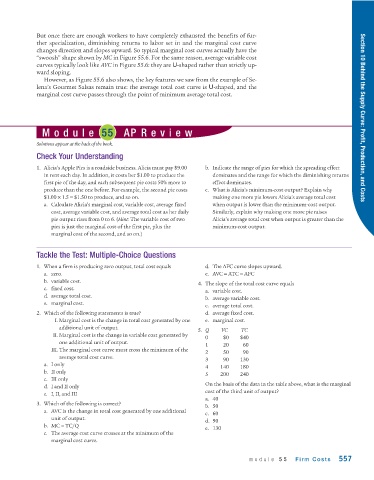Page 599 - Krugmans Economics for AP Text Book_Neat
P. 599
But once there are enough workers to have completely exhausted the benefits of fur-
ther specialization, diminishing returns to labor set in and the marginal cost curve
changes direction and slopes upward. So typical marginal cost curves actually have the
“swoosh” shape shown by MC in Figure 55.6. For the same reason, average variable cost
curves typically look like AVC in Figure 55.6: they are U-shaped rather than strictly up-
ward sloping.
However, as Figure 55.6 also shows, the key features we saw from the example of Se-
lena’s Gourmet Salsas remain true: the average total cost curve is U-shaped, and the
marginal cost curve passes through the point of minimum average total cost.
Module 55 AP Review Section 10 Behind the Supply Curve: Profit, Production, and Costs
Solutions appear at the back of the book.
Check Your Understanding
1. Alicia’s Apple Pies is a roadside business. Alicia must pay $9.00 b. Indicate the range of pies for which the spreading effect
in rent each day. In addition, it costs her $1.00 to produce the dominates and the range for which the diminishing returns
first pie of the day, and each subsequent pie costs 50% more to effect dominates.
produce than the one before. For example, the second pie costs c. What is Alicia’s minimum-cost output? Explain why
$1.00 × 1.5 = $1.50 to produce, and so on. making one more pie lowers Alicia’s average total cost
a. Calculate Alicia’s marginal cost, variable cost, average fixed when output is lower than the minimum-cost output.
cost, average variable cost, and average total cost as her daily Similarly, explain why making one more pie raises
pie output rises from 0 to 6. (Hint: The variable cost of two Alicia’s average total cost when output is greater than the
pies is just the marginal cost of the first pie, plus the minimum-cost output.
marginal cost of the second, and so on.)
Tackle the Test: Multiple-Choice Questions
1. When a firm is producing zero output, total cost equals d. The AFC curve slopes upward.
a. zero. e. AVC = ATC − AFC
b. variable cost.
4. The slope of the total cost curve equals
c. fixed cost.
a. variable cost.
d. average total cost.
b. average variable cost.
e. marginal cost.
c. average total cost.
2. Which of the following statements is true? d. average fixed cost.
I. Marginal cost is the change in total cost generated by one e. marginal cost.
additional unit of output.
5. Q VC TC
II. Marginal cost is the change in variable cost generated by
0 $0 $40
one additional unit of output.
1 20 60
III. The marginal cost curve must cross the minimum of the
2 50 90
average total cost curve.
3 90 130
a. I only 4 140 180
b. II only 5 200 240
c. III only
On the basis of the data in the table above, what is the marginal
d. I and II only
cost of the third unit of output?
e. I, II, and III
a. 40
3. Which of the following is correct?
b. 50
a. AVC is the change in total cost generated by one additional
c. 60
unit of output.
d. 90
b. MC = TC/Q
e. 130
c. The average cost curve crosses at the minimum of the
marginal cost curve.
module 55 Firm Costs 557

